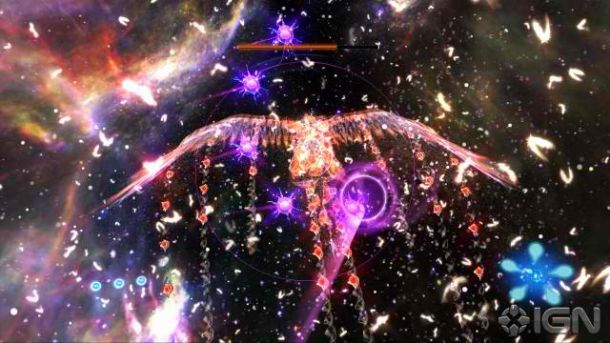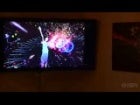Despite all that, I admittedly spent my first two days with the game using only a controller. Months of Kinect malaise pushed the thoughts of that wondrous presentation behind the present reality of rearranging my furniture to utilize a dust-lined sensor bar. With a controller, Child of Eden remains a wholly enthralling game, as the rhythmic shooting action -- in which you guide a cursor to blast waves of flying foes -- and thoroughly dazzling visuals and sound design capture you in a way that few other games can. But initially, before Child of Eden's challenge level solidified in the later stages, it felt like I was enjoying the game's looks and sound to a greater extent than I was enjoying the in-game action.
That changed significantly once I switched over to Kinect. Child of Eden absolutely comes to life as an interactive experience with motion controls, as the hand gestures put you directly in command of this dizzying universe of sight and sound. Using your right hand for lock-on shots and the left for steady fire -- or alternately, clapping your hands to switch weapons on a single hand -- works remarkably well, with fluid onscreen results. With Kinect, it's easier to shoot down entire waves of missiles, plus the whole game takes on a surprisingly amplified tenor thanks to the steady physical interaction. By the end of each stage, I was tapping my feet like a madman and shaking to the beat, as if the virtual energy beams I fired from my hands were still pulsing through my body. I appreciated the presentation more while sitting in a dark room with a controller, but enjoyed the actual combat to a much grander extent when I was on my feet with Kinect.
But even without Kinect, Child of Eden still delivers a fantastic artistic statement unlike any big-budget retail release in recent memory. Like spiritual predecessor Rez, Child of Eden's aesthetic approach seems tailor-made to encapsulate you within the experience, and the design has evolved to match the updated hardware -- with thoroughly mesmerizing results. Beautiful natural imagery (like birds and flowers) clashes wonderfully with flashing lights and robotic enemies amidst these vibrant animated backdrops, with thumping beats and catchy lyrics from Mizuguchi's band (Genki Rockets) propelling the journey.

Luckily, Child of Eden presents much more than a daze of unintelligible psychedelic imagery. Some moments transform the adventure and stick with you, such as seeing a pair of energy balls change into dueling human sprinters, or viewing video clips of historical advancements in flight that emerge in the wake of fallen targets. Such segments hint at a deeper subtext to the visual cacophony, and it's all wrapped up in full-motion video clips of Lumi, the fictional woman whose memories you're trying to revive through this frenzied fever dream of a game. It's a wonder that such boundless creativity remains unrestrained in a major release from a large publisher, but such thoughts are quickly forgotten during the moments of blissful serenity found amidst the chaos.
Child of Eden isn't a tremendously robust game on the surface, as the five main stages and bonus challenge mode can be cracked within a couple of hours... but between the control options, visual filters, and difficulty settings, you'll likely spin through each several times before you're truly satisfied. My only notable concern -- aside from the barely evolved core game design from the nearly decade-old Rez -- is that the game's menu-heavy design and disconnected mission structure arrive in stark opposition to the enveloping feel of the actual stages. I wanted to live in this world, yet I was flinging through rigid menus every 10-15 minutes. Otherwise, though, Child of Eden marks a startlingly modern experience, one that marries unparalleled aesthetic design with motion controls that actually matter, resulting in a one-of-a-kind trip that promises to stick with you long after you've liberated Lumi.





 Outstanding!
Outstanding!


